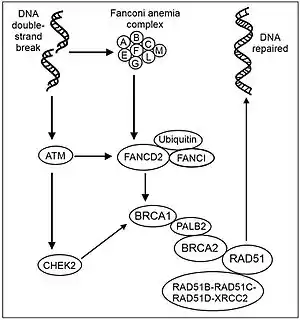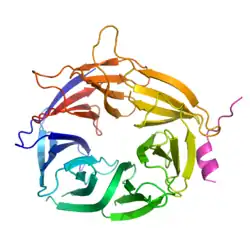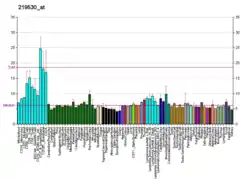PALB2
Partner and localizer of BRCA2, also known as PALB2 or FANCN, is a protein which in humans is encoded by the PALB2 gene.[5][6][7]
Function


This gene encodes a protein that functions in genome maintenance (double strand break repair). This protein binds to and colocalizes with the breast cancer 2 early onset protein (BRCA2) in nuclear foci and likely permits the stable intranuclear localization and accumulation of BRCA2.[5] PALB2 binds the single strand DNA and directly interacts with the recombinase RAD51 to stimulate strand invasion, a vital step of homologous recombination,[15] PALB2 can function synergistically with a BRCA2 chimera (termed piccolo, or piBRCA2) to further promote strand invasion.[15]
Clinical significance
Variants in the PALB2 gene are associated with an increased risk of developing breast cancer [16] of magnitude similar to that associated with BRCA2 mutations [17] and PALB2-deficient cells are sensitive to PARP inhibitors.[15]
PALB2 was recently identified as a susceptibility gene for familial pancreatic cancer by scientists at the Sol Goldman Pancreatic Cancer Research Center at Johns Hopkins. This has paved for the way for developing a new gene test for families where pancreatic cancer occurs in multiple family members.[18] Tests for PALB2 have been developed by Ambry Genetics [19] and Myriad Genetics[20] that are now available. The PALB2 Interest Group (PALB2.org) is an international consortium of scientists and clinicians who coordinate research into this gene. They are keen to hear from women and men with PALB2 mutations.
Prophylactic mastectomy should be considered for women that had breast cancer and a PALB2 mutation.[21][22]
Biallelic mutations in PALB2 (also known as FANCN), similar to biallelic BRCA2 mutations, cause Fanconi anemia.[7]
Mutations in this gene have been associated with an increased risk of ovarian, breast and pancreatic cancer.[23]
Meiosis
PALB2 mutant male mice have reduced fertility.[24] This reduced fertility appears to be due to germ cell attrition resulting from a combination of unrepaired DNA breaks during meiosis and defective synapsis of the X and Y chromosomes. The function of homologous recombination during meiosis appears to be repair of DNA damages, particularly double-strand breaks (also see Origin and function of meiosis). The PALB2-BRCA1 interaction is likely important for repairing such damages during male meiosis.
References
- GRCh38: Ensembl release 89: ENSG00000083093 - Ensembl, May 2017
- GRCm38: Ensembl release 89: ENSMUSG00000044702 - Ensembl, May 2017
- "Human PubMed Reference:". National Center for Biotechnology Information, U.S. National Library of Medicine.
- "Mouse PubMed Reference:". National Center for Biotechnology Information, U.S. National Library of Medicine.
- "Entrez Gene: PALB2 partner and localizer of BRCA2".
- Xia B, Sheng Q, Nakanishi K, Ohashi A, Wu J, Christ N, et al. (June 2006). "Control of BRCA2 cellular and clinical functions by a nuclear partner, PALB2". Molecular Cell. 22 (6): 719–29. doi:10.1016/j.molcel.2006.05.022. PMID 16793542.
- Xia B, Dorsman JC, Ameziane N, de Vries Y, Rooimans MA, Sheng Q, et al. (February 2007). "Fanconi anemia is associated with a defect in the BRCA2 partner PALB2". Nature Genetics. 39 (2): 159–61. doi:10.1038/ng1942. PMID 17200672. S2CID 36491877.
- D'Andrea AD (May 2010). "Susceptibility pathways in Fanconi's anemia and breast cancer". The New England Journal of Medicine. 362 (20): 1909–19. doi:10.1056/NEJMra0809889. PMC 3069698. PMID 20484397.
- Sobeck A, Stone S, Landais I, de Graaf B, Hoatlin ME (September 2009). "The Fanconi anemia protein FANCM is controlled by FANCD2 and the ATR/ATM pathways". The Journal of Biological Chemistry. 284 (38): 25560–8. doi:10.1074/jbc.M109.007690. PMC 2757957. PMID 19633289.
- Castillo P, Bogliolo M, Surralles J (May 2011). "Coordinated action of the Fanconi anemia and ataxia telangiectasia pathways in response to oxidative damage". DNA Repair. 10 (5): 518–25. doi:10.1016/j.dnarep.2011.02.007. PMID 21466974.
- Stolz A, Ertych N, Bastians H (February 2011). "Tumor suppressor CHK2: regulator of DNA damage response and mediator of chromosomal stability". Clinical Cancer Research. 17 (3): 401–5. doi:10.1158/1078-0432.CCR-10-1215. PMID 21088254.
- Taniguchi T, Garcia-Higuera I, Andreassen PR, Gregory RC, Grompe M, D'Andrea AD (October 2002). "S-phase-specific interaction of the Fanconi anemia protein, FANCD2, with BRCA1 and RAD51". Blood. 100 (7): 2414–20. doi:10.1182/blood-2002-01-0278. PMID 12239151. S2CID 11001855.
- Park JY, Zhang F, Andreassen PR (August 2014). "PALB2: the hub of a network of tumor suppressors involved in DNA damage responses". Biochimica et Biophysica Acta (BBA) - Reviews on Cancer. 1846 (1): 263–75. doi:10.1016/j.bbcan.2014.06.003. PMC 4183126. PMID 24998779.
- Chun J, Buechelmaier ES, Powell SN (January 2013). "Rad51 paralog complexes BCDX2 and CX3 act at different stages in the BRCA1-BRCA2-dependent homologous recombination pathway". Molecular and Cellular Biology. 33 (2): 387–95. doi:10.1128/MCB.00465-12. PMC 3554112. PMID 23149936.
- Buisson R, Dion-Côté AM, Coulombe Y, Launay H, Cai H, Stasiak AZ, et al. (October 2010). "Cooperation of breast cancer proteins PALB2 and piccolo BRCA2 in stimulating homologous recombination". Nature Structural & Molecular Biology. 17 (10): 1247–54. doi:10.1038/nsmb.1915. PMC 4094107. PMID 20871615.
- Chen P, Liang J, Wang Z, Zhou X, Chen L, Li M, et al. (September 2008). "Association of common PALB2 polymorphisms with breast cancer risk: a case-control study". Clinical Cancer Research. 14 (18): 5931–7. doi:10.1158/1078-0432.CCR-08-0429. PMID 18794107.
- Antoniou AC, Casadei S, Heikkinen T, Barrowdale D, Pylkäs K, Roberts J, et al. (August 2014). "Breast-cancer risk in families with mutations in PALB2". The New England Journal of Medicine. 371 (6): 497–506. doi:10.1056/NEJMoa1400382. PMC 4157599. PMID 25099575.
- Jones S, Hruban RH, Kamiyama M, Borges M, Zhang X, Parsons DW, et al. (April 2009). "Exomic sequencing identifies PALB2 as a pancreatic cancer susceptibility gene". Science. 324 (5924): 217. Bibcode:2009Sci...324..217J. doi:10.1126/science.1171202. PMC 2684332. PMID 19264984.
- "Ambry Genetics".
- "Myriad Genetics".
- Wright FC, Look Hong NJ, Quan ML, Beyfuss K, Temple S, Covelli A, et al. (February 2018). "Indications for Contralateral Prophylactic Mastectomy: A Consensus Statement Using Modified Delphi Methodology". Annals of Surgery. 267 (2): 271–279. doi:10.1097/SLA.0000000000002309. PMID 28594745. S2CID 28223281.
- Song CV, Teo SH, Taib NA, Yip CH (2018). "BRCA, TP53 and PALB2: a literature review". ecancermedicalscience. 12: 863. doi:10.3332/ecancer.2018.863. PMC 6113980. PMID 30174725.
- Yang X, Leslie G, Doroszuk A, Schneider S, Allen J, Decker B, et al. (December 2019). "PALB2 Pathogenic Variants: An International Study of 524 Families". Journal of Clinical Oncology. 38 (7): 674–685. doi:10.1200/JCO.19.01907. PMC 7049229. PMID 31841383.
- Simhadri S, Peterson S, Patel DS, Huo Y, Cai H, Bowman-Colin C, et al. (August 2014). "Male fertility defect associated with disrupted BRCA1-PALB2 interaction in mice". The Journal of Biological Chemistry. 289 (35): 24617–29. doi:10.1074/jbc.M114.566141. PMC 4148885. PMID 25016020.
Further reading
- Beausoleil SA, Jedrychowski M, Schwartz D, Elias JE, Villén J, Li J, et al. (August 2004). "Large-scale characterization of HeLa cell nuclear phosphoproteins". Proceedings of the National Academy of Sciences of the United States of America. 101 (33): 12130–5. Bibcode:2004PNAS..10112130B. doi:10.1073/pnas.0404720101. PMC 514446. PMID 15302935.
- Kimura K, Wakamatsu A, Suzuki Y, Ota T, Nishikawa T, Yamashita R, et al. (January 2006). "Diversification of transcriptional modulation: large-scale identification and characterization of putative alternative promoters of human genes". Genome Research. 16 (1): 55–65. doi:10.1101/gr.4039406. PMC 1356129. PMID 16344560.
- Xia B, Sheng Q, Nakanishi K, Ohashi A, Wu J, Christ N, et al. (June 2006). "Control of BRCA2 cellular and clinical functions by a nuclear partner, PALB2". Molecular Cell. 22 (6): 719–29. doi:10.1016/j.molcel.2006.05.022. PMID 16793542.
- Rahman N, Seal S, Thompson D, Kelly P, Renwick A, Elliott A, et al. (February 2007). "PALB2, which encodes a BRCA2-interacting protein, is a breast cancer susceptibility gene". Nature Genetics. 39 (2): 165–7. doi:10.1038/ng1959. PMC 2871593. PMID 17200668.
- Reid S, Schindler D, Hanenberg H, Barker K, Hanks S, Kalb R, et al. (February 2007). "Biallelic mutations in PALB2 cause Fanconi anemia subtype FA-N and predispose to childhood cancer". Nature Genetics. 39 (2): 162–4. doi:10.1038/ng1947. PMID 17200671. S2CID 10326242.
- Xia B, Dorsman JC, Ameziane N, de Vries Y, Rooimans MA, Sheng Q, et al. (February 2007). "Fanconi anemia is associated with a defect in the BRCA2 partner PALB2". Nature Genetics. 39 (2): 159–61. doi:10.1038/ng1942. PMID 17200672. S2CID 36491877.
- Erkko H, Xia B, Nikkilä J, Schleutker J, Syrjäkoski K, Mannermaa A, et al. (March 2007). "A recurrent mutation in PALB2 in Finnish cancer families". Nature. 446 (7133): 316–9. Bibcode:2007Natur.446..316E. doi:10.1038/nature05609. PMID 17287723. S2CID 4340489.
- Tischkowitz M, Xia B, Sabbaghian N, Reis-Filho JS, Hamel N, Li G, et al. (April 2007). "Analysis of PALB2/FANCN-associated breast cancer families". Proceedings of the National Academy of Sciences of the United States of America. 104 (16): 6788–93. Bibcode:2007PNAS..104.6788T. doi:10.1073/pnas.0701724104. PMC 1871863. PMID 17420451.
- Oliver AW, Swift S, Lord CJ, Ashworth A, Pearl LH (September 2009). "Structural basis for recruitment of BRCA2 by PALB2". EMBO Reports. 10 (9): 990–6. doi:10.1038/embor.2009.126. PMC 2750052. PMID 19609323.






